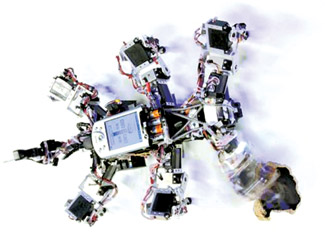|

A walking robot that
switches gaits
Even simple insects can generate quite different movement patterns
with their six legs. The animal uses various gaits (manner of
walking)depending on whether it crawls uphill or downhill, slowly or
fast. Scientists from Gottingen have now developed a walking robot,
which depending on the situation can flexibly and autonomously switch
between different gaits. The success of their solution lies in its
simplicity: a small and simple network with just a few connections can
create very diverse movement patterns.
|

Following the principle of chaos control, the robot produces
regular leg movements when walking normally. In addition, it can
use the uncontrolled chaotic movement pattern to free itself
when its leg is trapped in a hole. |
To this end, the robot uses a mechanism for “chaos control.” This
interdisciplinary work was carried out by a team of scientists at the
Bernstein Center for Computational Neuroscience Gottingen, the Physics
Department of the Georg-August-University of Gottingen and the Max
Planck Institute for Dynamics and Self-Organization.
In humans and animals, periodically recurring movements like walking
or breathing are controlled by small neural circuits called “central
pattern generators” (CPG). Scientists have been using this principle in
the development of walking machines.
To date, typically one separate CPG was needed for every gait. The
robot receives information about its environment via several sensors —
about whether there is an obstacle in front of it or whether it climbs a
slope. Based on this information, it selects the CPG controlling the
gait that is appropriate for the respective situation.
One single pattern generator for many gaits.
The robot developed by the Gottingen scientists now manages the same
task with only one CPG that generates entirely different gaits and which
can switch between these gaits in a flexible manner.
This CPG is a tiny network consisting of two circuit elements. The
secret of its functioning lies in the so-called “chaos control.” If
uncontrolled, the CPG produces a chaotic activity pattern. This
activity, however, can very easily be controlled by the sensor inputs
into periodic patterns that determine the gait. Depending on the sensory
input signal, different patterns — and thus different gaits — are
generated.
The connection between sensory properties and CPG can either be
preprogrammed or learned by the robot from experience. The scientists
use a key example to show how this works: the robot can autonomously
learn to walk up a slope with as little energy input as possible. As
soon as the robot reaches a slope, a sensor shows that the energy
consumption is too high.
Thereupon, the connection between the sensor and the control input of
the CPG is varied until a gait is found that allows the robot to consume
less energy. Once the right connections have been established, the robot
has learned the relation between slope and gait. When it tries to climb
the hill a second time, it will immediately adopt the appropriate gait.
In the future, the robot will also be equipped with a memory device
which will enable it to complete movements even after the sensory input
ceases to exist. In order to walk over an obstacle, for instance, the
robot would have to take a large step with each of its six legs.
“Currently, the robot would not be able to handle this task — as soon
as the obstacle is out of sight, it no longer knows which gait to use,”
says Marc Timme, scientist at the Max Planck Institute for Dynamics and
Self-Organization. “Once the robot is equipped with a motor memory, it
will be capable to use foresight and plan its movements.”
(Courtesy: Science Daily)
World's
highest airport in Tibet?
China is to build the world's highest airport, at an altitude of
4,436 metres (14,500ft), in Tibet. The construction, at Nagqu, is likely
to be a daunting task given the altitude and climate, with average
temperatures staying below zero throughout the year.The airport will be
just 764 metres lower than the Mount Everest base camp
|

One of the six airports in Tibet - the Roof of the world. |
on the Chinese side, which is located 5,200 metres above sea
level.Nagqu is in the centre of the Qinghai-Tibet plateau, about 186
miles from the Tibetan capital of Lhasa, with a population of 400,000.
The airport will be the sixth in Tibet, and its addition means there
will be one airport in each prefecture."The airport construction is
planned for 2011 with a construction period of three years," said Xu
Jian, director of the Nagqu committee of development and reform.
"It is expected to cost 1.8bn yuan [£160m] and cover an area of
233-266 hectares."China announced in 2008 that it would build 97 new
airports by 2020, so that four-fifths of the population would be within
a 90-minute drive of an airport."With the airport, Nagqu, which is also
on the Qinghai-Tibet railway line, is expected to become the centre of
an economic hub in the plateau region," said Tan Yongshou, commissioner
of the prefecture.Xu Bo, director of the Tibetan branch of the China
civil aviation administration, added: " The objective for the next stage
of development is to open direct air routes from Tibet to south Asian
countries."The new airport will beat the current altitude record holder
“ Bamda airport in Bangda, Qamdo, which, also in Tibet, sits at an
elevation of 4,334 metres.
That airport overtook the one at Lhasa, which has been built at a
mere 3,600 metres.The plans underline the astonishing speed with which
China is unrolling ambitious infrastructure projects, often under
challenging conditions, and, in particular, highlights the rapid
development occurring in Tibet.An extraordinary railway line connecting
Tibet to the rest of China opened four years ago, and the government is
constructing six new rail lines in and around the vast region, which is
rich in natural resources.Beijing argues that such changes are needed to
boost growth and raise living standards.
Courtesy:-AFP |

